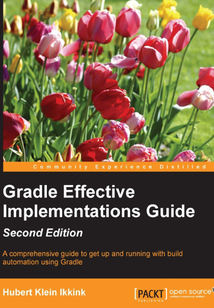目錄(97章)
倒序
- coverpage
- Gradle Effective Implementations Guide - Second Edition
- Credits
- About the Author
- About the Reviewer
- www.PacktPub.com
- Why subscribe?
- Free access for Packt account holders
- Preface
- What this book covers
- What you need for this book
- Who this book is for
- Conventions
- Reader feedback
- Customer support
- Chapter 1. Starting with Gradle
- Declarative builds and convention over configuration
- Getting started
- Writing our first build script
- Default Gradle tasks
- Task name abbreviation
- Executing multiple tasks
- Command-line options
- Understanding the Gradle graphical user interface
- Summary
- Chapter 2. Creating Gradle Build Scripts
- Writing a build script
- Defining tasks
- Build scripts are Groovy code
- Setting default tasks
- Organizing tasks
- Adding tasks in other ways
- Accessing tasks as project properties
- Adding additional properties to tasks
- Avoiding common pitfalls
- Skipping tasks
- Summary
- Chapter 3. Working with Gradle Build Scripts
- Working with files
- Project properties
- Using logging
- Using the Gradle Wrapper
- Summary
- Chapter 4. Using Gradle for Java Projects
- Why plugins?
- Getting started with the Java plugin
- Working with source sets
- Working with properties
- Creating Javadoc documentation
- Summary
- Chapter 5. Dependency Management
- Dependency configuration
- Repositories
- Defining dependencies
- Summary
- Chapter 6. Testing Building and Publishing Artifacts
- Testing our projects
- Running Java applications
- Publishing artifacts
- Packaging Java Enterprise Edition applications
- Summary
- Chapter 7. Multi-project Builds
- Working with multi-project builds
- Working with Java multi-project builds
- Using the Jetty plugin
- Summary
- Chapter 8. Mixed Languages
- Using the Groovy plugin
- Using the Scala plugin
- Summary
- Chapter 9. Maintaining Code Quality
- Using the Checkstyle plugin
- Using the PMD plugin
- Using the FindBugs plugin
- Using the JDepend plugin
- Using the CodeNarc plugin
- Summary
- Chapter 10. Writing Custom Tasks and Plugins
- Creating a custom task
- Creating a task in a standalone project
- Creating a custom plugin
- Creating a plugin in the project source directory
- Creating a plugin in a standalone project
- Summary
- Chapter 11. Gradle in the Enterprise
- Creating a sample project
- Using Jenkins
- Using JetBrains TeamCity
- Using Atlassian Bamboo
- Summary
- Chapter 12. IDE Support
- Using the Eclipse plugin
- Using the IntelliJ IDEA plugin
- Running Gradle in Eclipse
- Running Gradle in IntelliJ IDEA
- Summary 更新時(shí)間:2021-07-16 10:43:44
推薦閱讀
- 從零開始寫Linux內(nèi)核:一書學(xué)透核心原理與實(shí)現(xiàn)
- WindowsServer2012Hyper-V虛擬化部署與管理指南
- Windows Server 2012 Hyper-V Cookbook
- 異質(zhì)結(jié)原理與器件
- 嵌入式系統(tǒng)及其應(yīng)用(第三版)
- Dreamweaver CS5.5 Mobile and Web Development with HTML5,CSS3,and jQuery
- VMware NSX Cookbook
- INSTANT Migration from Windows Server 2008 and 2008 R2 to 2012 How-to
- OpenSolaris設(shè)備驅(qū)動(dòng)原理與開發(fā)
- Windows 7實(shí)戰(zhàn)從入門到精通
- Zabbix監(jiān)控系統(tǒng)之深度解析和實(shí)踐
- VMware Horizon Mirage Essentials
- Mastering Eclipse Plug-in Development
- Getting Started with Raspberry Pi Zero
- Linux從入門到精通
- 鴻蒙應(yīng)用程序開發(fā)
- Windows8應(yīng)用開發(fā)權(quán)威指南
- TD-SCDMA HSDPA系統(tǒng)設(shè)計(jì)與組網(wǎng)技術(shù)
- UG NX 實(shí)例教程(第2版)
- Instant XenMobile MDM
- 電腦辦公(Windows 10+Office 2016)從入門到精通
- Windows 10入門與提高(超值版)
- IBM Cognos BI v10.2 Administration Essentials
- Docker on Windows
- UML和OOAD快速入門
- Getting Started with Windows VDI
- Linux命令應(yīng)用大詞典
- 開源安全運(yùn)維平臺(tái)OSSIM疑難解析:提高篇
- Selenium WebDriver Quick Start Guide
- 鴻蒙應(yīng)用開發(fā)入門


